A Strategic Control Analysis Report: The Coca-Cola Company Overview
VerifiedAdded on 2019/11/29
|12
|2701
|128
Report
AI Summary
This assignment provides a comprehensive analysis of the Coca-Cola Company's strategic control. It begins with an executive summary and an introduction, highlighting the importance of strategic controls in the business. The report delves into Coca-Cola's mission and vision statements, followed by a detailed SWOT analysis, examining the company's strengths, weaknesses, opportunities, and threats. The organizational structure and culture of Coca-Cola are discussed, along with its key strategic controls, including budgeting, information systems, and human resource management. The report critically evaluates the fit between organizational goals and implemented strategies, analyzes ethical perceptions within the company, and concludes with recommendations for improvements, such as product diversification, to ensure the company's continued success and adapt to changing consumer preferences and health consciousness. The report emphasizes the significance of transparency, trustworthiness, and sustainability in Coca-Cola's business practices and offers insights into how the company can enhance its ethical standing and corporate social responsibility.
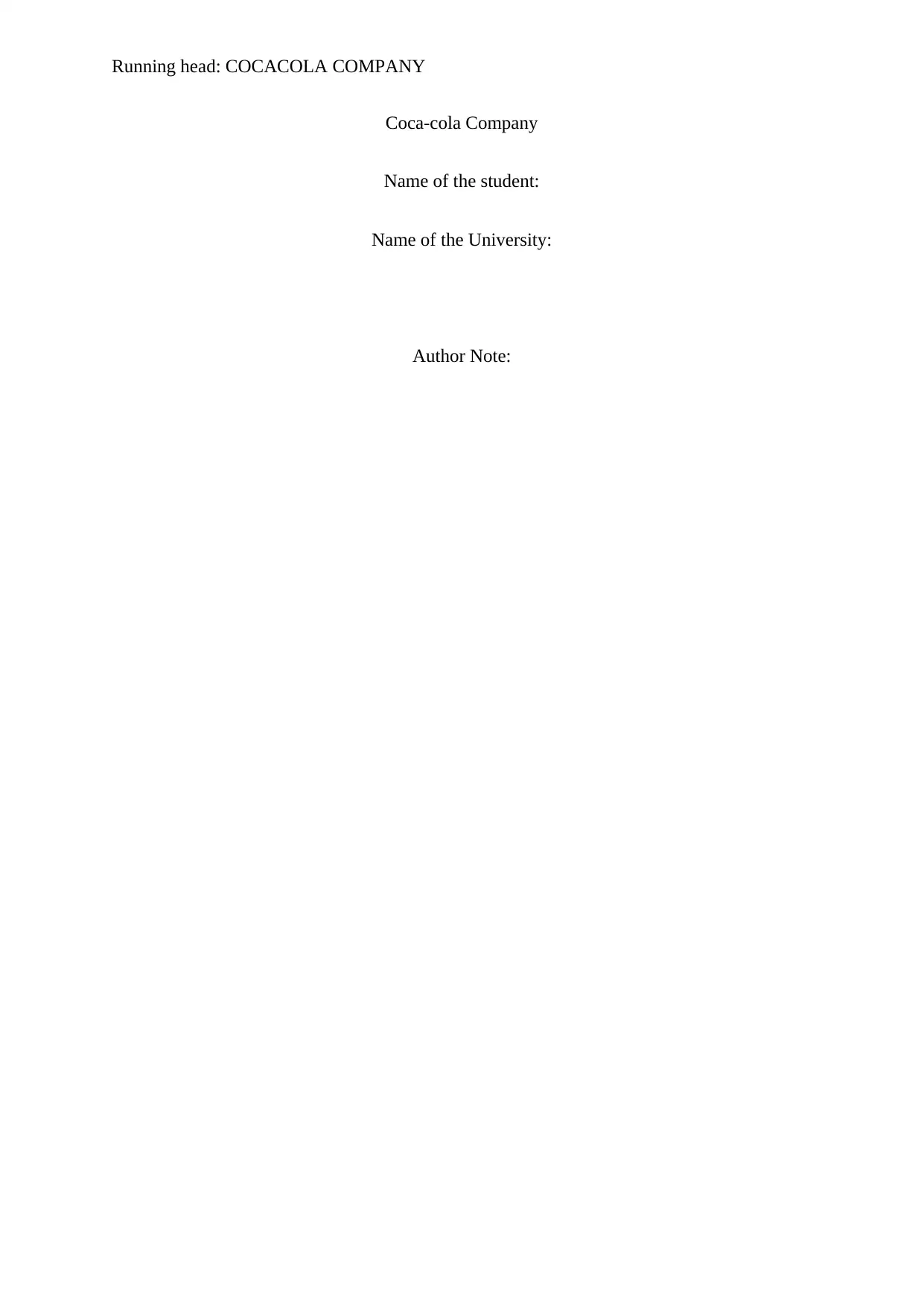
Running head: COCACOLA COMPANY
Coca-cola Company
Name of the student:
Name of the University:
Author Note:
Coca-cola Company
Name of the student:
Name of the University:
Author Note:
Paraphrase This Document
Need a fresh take? Get an instant paraphrase of this document with our AI Paraphraser
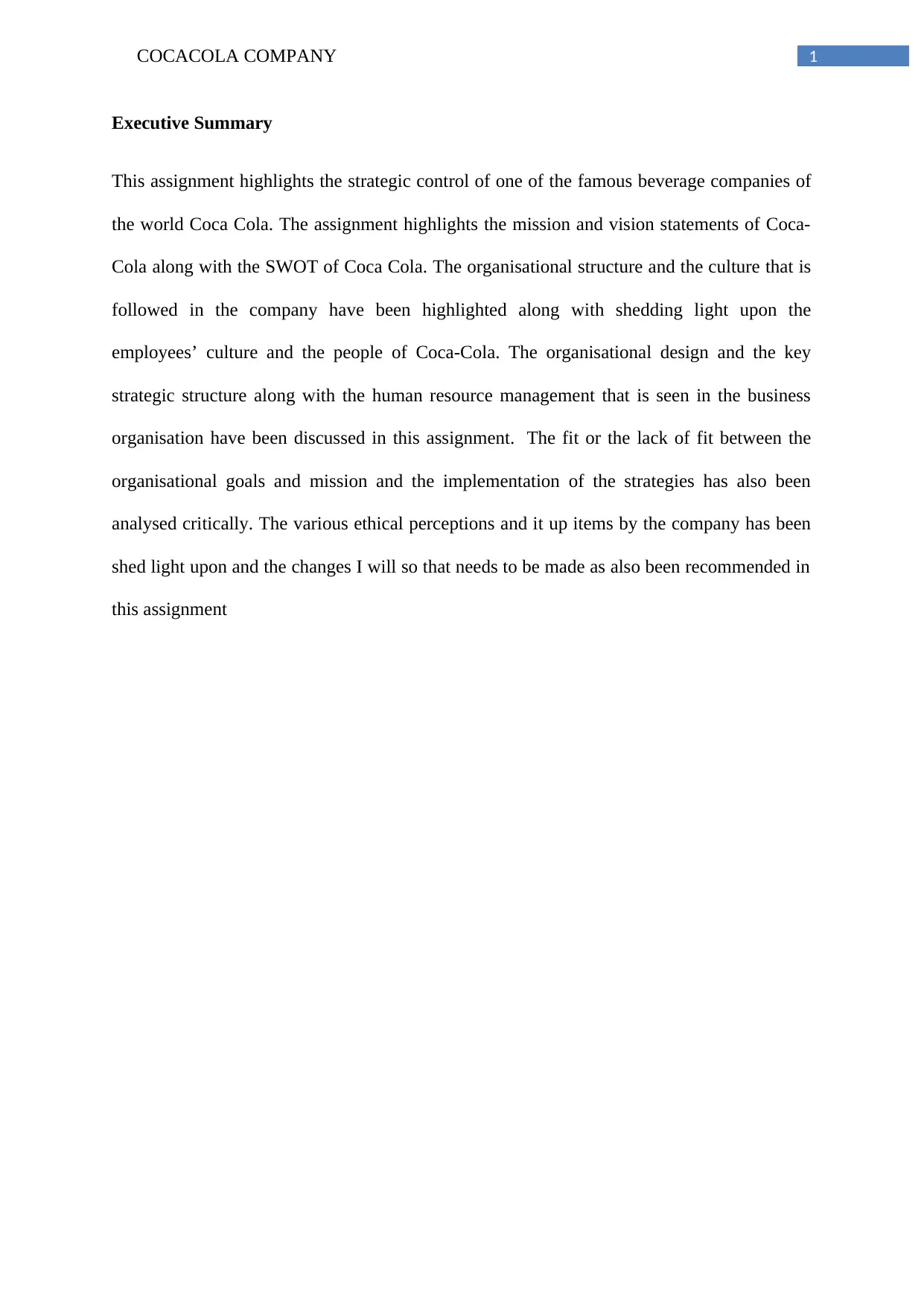
1COCACOLA COMPANY
Executive Summary
This assignment highlights the strategic control of one of the famous beverage companies of
the world Coca Cola. The assignment highlights the mission and vision statements of Coca-
Cola along with the SWOT of Coca Cola. The organisational structure and the culture that is
followed in the company have been highlighted along with shedding light upon the
employees’ culture and the people of Coca-Cola. The organisational design and the key
strategic structure along with the human resource management that is seen in the business
organisation have been discussed in this assignment. The fit or the lack of fit between the
organisational goals and mission and the implementation of the strategies has also been
analysed critically. The various ethical perceptions and it up items by the company has been
shed light upon and the changes I will so that needs to be made as also been recommended in
this assignment
Executive Summary
This assignment highlights the strategic control of one of the famous beverage companies of
the world Coca Cola. The assignment highlights the mission and vision statements of Coca-
Cola along with the SWOT of Coca Cola. The organisational structure and the culture that is
followed in the company have been highlighted along with shedding light upon the
employees’ culture and the people of Coca-Cola. The organisational design and the key
strategic structure along with the human resource management that is seen in the business
organisation have been discussed in this assignment. The fit or the lack of fit between the
organisational goals and mission and the implementation of the strategies has also been
analysed critically. The various ethical perceptions and it up items by the company has been
shed light upon and the changes I will so that needs to be made as also been recommended in
this assignment
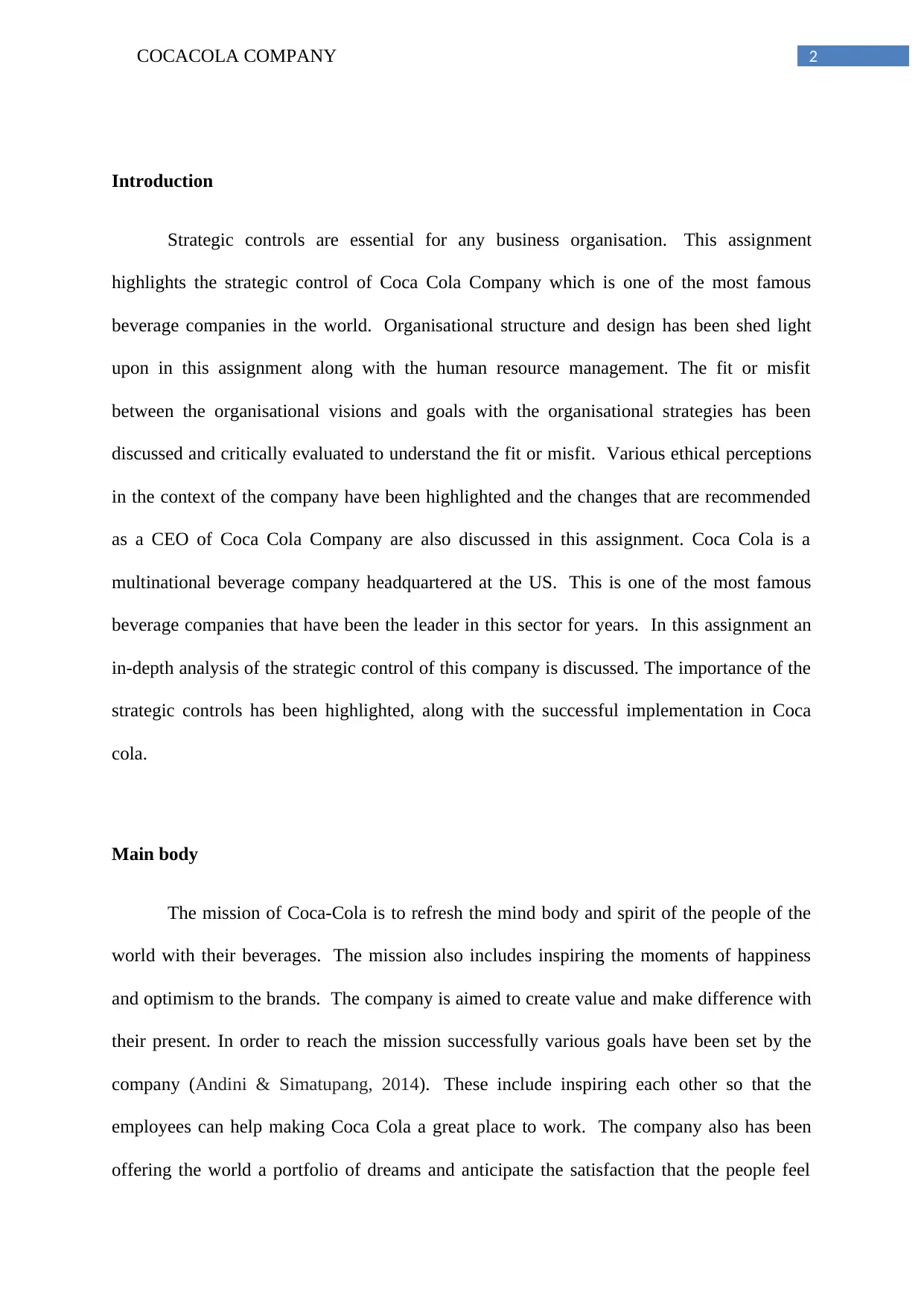
2COCACOLA COMPANY
Introduction
Strategic controls are essential for any business organisation. This assignment
highlights the strategic control of Coca Cola Company which is one of the most famous
beverage companies in the world. Organisational structure and design has been shed light
upon in this assignment along with the human resource management. The fit or misfit
between the organisational visions and goals with the organisational strategies has been
discussed and critically evaluated to understand the fit or misfit. Various ethical perceptions
in the context of the company have been highlighted and the changes that are recommended
as a CEO of Coca Cola Company are also discussed in this assignment. Coca Cola is a
multinational beverage company headquartered at the US. This is one of the most famous
beverage companies that have been the leader in this sector for years. In this assignment an
in-depth analysis of the strategic control of this company is discussed. The importance of the
strategic controls has been highlighted, along with the successful implementation in Coca
cola.
Main body
The mission of Coca-Cola is to refresh the mind body and spirit of the people of the
world with their beverages. The mission also includes inspiring the moments of happiness
and optimism to the brands. The company is aimed to create value and make difference with
their present. In order to reach the mission successfully various goals have been set by the
company (Andini & Simatupang, 2014). These include inspiring each other so that the
employees can help making Coca Cola a great place to work. The company also has been
offering the world a portfolio of dreams and anticipate the satisfaction that the people feel
Introduction
Strategic controls are essential for any business organisation. This assignment
highlights the strategic control of Coca Cola Company which is one of the most famous
beverage companies in the world. Organisational structure and design has been shed light
upon in this assignment along with the human resource management. The fit or misfit
between the organisational visions and goals with the organisational strategies has been
discussed and critically evaluated to understand the fit or misfit. Various ethical perceptions
in the context of the company have been highlighted and the changes that are recommended
as a CEO of Coca Cola Company are also discussed in this assignment. Coca Cola is a
multinational beverage company headquartered at the US. This is one of the most famous
beverage companies that have been the leader in this sector for years. In this assignment an
in-depth analysis of the strategic control of this company is discussed. The importance of the
strategic controls has been highlighted, along with the successful implementation in Coca
cola.
Main body
The mission of Coca-Cola is to refresh the mind body and spirit of the people of the
world with their beverages. The mission also includes inspiring the moments of happiness
and optimism to the brands. The company is aimed to create value and make difference with
their present. In order to reach the mission successfully various goals have been set by the
company (Andini & Simatupang, 2014). These include inspiring each other so that the
employees can help making Coca Cola a great place to work. The company also has been
offering the world a portfolio of dreams and anticipate the satisfaction that the people feel
⊘ This is a preview!⊘
Do you want full access?
Subscribe today to unlock all pages.

Trusted by 1+ million students worldwide

3COCACOLA COMPANY
after consumption of the drink (Suliman, Al-Khatib & Thomas, 2016). The company
believes in nurturing winning network of partners and customers are mutually loyal to each
other. They considered themselves as responsible global citizens and work towards initiating
sustainable communities. One of the essential goals is to maximize their long term return to
the shareholders and ensure effective productivity that is ideal for a fast moving organisation
(Krzywoszynska, 2015).
The SWOT analysis highlights the internal factors that affect the business
organization. The strengths, weaknesses, opportunities and threats that the company faces,
has been highlighted in this assignment.
Strengths
Leader in the world of beverages
World’s largest beverage company
Popular among the customers
(Barkay, 2013)
Strong marketing and advertisement
Wide variety of beverages
Weaknesses
Major dependency on carbonated
drinks
Lack of effective diversification
Negative publicity
Harmful for health
Opportunities
Growth in beverage consumption
Introduction of non-carbonated drinks
Increasing demand for bottled water
More brand recognition
Threats
Health consciousness among the
people
Changes in the consumer’s demands
for a healthier option
Increased competition in the beverage
industry
after consumption of the drink (Suliman, Al-Khatib & Thomas, 2016). The company
believes in nurturing winning network of partners and customers are mutually loyal to each
other. They considered themselves as responsible global citizens and work towards initiating
sustainable communities. One of the essential goals is to maximize their long term return to
the shareholders and ensure effective productivity that is ideal for a fast moving organisation
(Krzywoszynska, 2015).
The SWOT analysis highlights the internal factors that affect the business
organization. The strengths, weaknesses, opportunities and threats that the company faces,
has been highlighted in this assignment.
Strengths
Leader in the world of beverages
World’s largest beverage company
Popular among the customers
(Barkay, 2013)
Strong marketing and advertisement
Wide variety of beverages
Weaknesses
Major dependency on carbonated
drinks
Lack of effective diversification
Negative publicity
Harmful for health
Opportunities
Growth in beverage consumption
Introduction of non-carbonated drinks
Increasing demand for bottled water
More brand recognition
Threats
Health consciousness among the
people
Changes in the consumer’s demands
for a healthier option
Increased competition in the beverage
industry
Paraphrase This Document
Need a fresh take? Get an instant paraphrase of this document with our AI Paraphraser
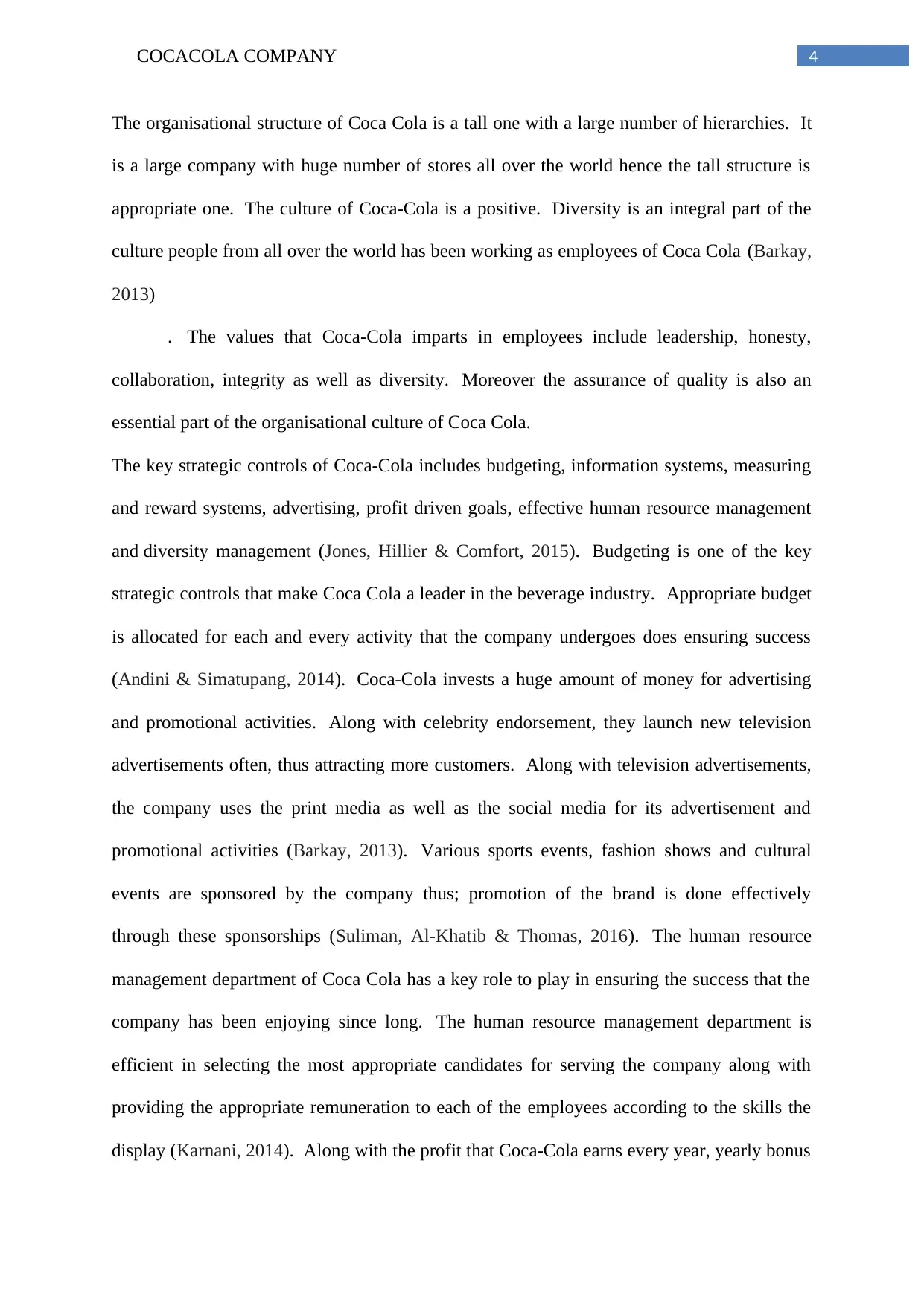
4COCACOLA COMPANY
The organisational structure of Coca Cola is a tall one with a large number of hierarchies. It
is a large company with huge number of stores all over the world hence the tall structure is
appropriate one. The culture of Coca-Cola is a positive. Diversity is an integral part of the
culture people from all over the world has been working as employees of Coca Cola (Barkay,
2013)
. The values that Coca-Cola imparts in employees include leadership, honesty,
collaboration, integrity as well as diversity. Moreover the assurance of quality is also an
essential part of the organisational culture of Coca Cola.
The key strategic controls of Coca-Cola includes budgeting, information systems, measuring
and reward systems, advertising, profit driven goals, effective human resource management
and diversity management (Jones, Hillier & Comfort, 2015). Budgeting is one of the key
strategic controls that make Coca Cola a leader in the beverage industry. Appropriate budget
is allocated for each and every activity that the company undergoes does ensuring success
(Andini & Simatupang, 2014). Coca-Cola invests a huge amount of money for advertising
and promotional activities. Along with celebrity endorsement, they launch new television
advertisements often, thus attracting more customers. Along with television advertisements,
the company uses the print media as well as the social media for its advertisement and
promotional activities (Barkay, 2013). Various sports events, fashion shows and cultural
events are sponsored by the company thus; promotion of the brand is done effectively
through these sponsorships (Suliman, Al-Khatib & Thomas, 2016). The human resource
management department of Coca Cola has a key role to play in ensuring the success that the
company has been enjoying since long. The human resource management department is
efficient in selecting the most appropriate candidates for serving the company along with
providing the appropriate remuneration to each of the employees according to the skills the
display (Karnani, 2014). Along with the profit that Coca-Cola earns every year, yearly bonus
The organisational structure of Coca Cola is a tall one with a large number of hierarchies. It
is a large company with huge number of stores all over the world hence the tall structure is
appropriate one. The culture of Coca-Cola is a positive. Diversity is an integral part of the
culture people from all over the world has been working as employees of Coca Cola (Barkay,
2013)
. The values that Coca-Cola imparts in employees include leadership, honesty,
collaboration, integrity as well as diversity. Moreover the assurance of quality is also an
essential part of the organisational culture of Coca Cola.
The key strategic controls of Coca-Cola includes budgeting, information systems, measuring
and reward systems, advertising, profit driven goals, effective human resource management
and diversity management (Jones, Hillier & Comfort, 2015). Budgeting is one of the key
strategic controls that make Coca Cola a leader in the beverage industry. Appropriate budget
is allocated for each and every activity that the company undergoes does ensuring success
(Andini & Simatupang, 2014). Coca-Cola invests a huge amount of money for advertising
and promotional activities. Along with celebrity endorsement, they launch new television
advertisements often, thus attracting more customers. Along with television advertisements,
the company uses the print media as well as the social media for its advertisement and
promotional activities (Barkay, 2013). Various sports events, fashion shows and cultural
events are sponsored by the company thus; promotion of the brand is done effectively
through these sponsorships (Suliman, Al-Khatib & Thomas, 2016). The human resource
management department of Coca Cola has a key role to play in ensuring the success that the
company has been enjoying since long. The human resource management department is
efficient in selecting the most appropriate candidates for serving the company along with
providing the appropriate remuneration to each of the employees according to the skills the
display (Karnani, 2014). Along with the profit that Coca-Cola earns every year, yearly bonus
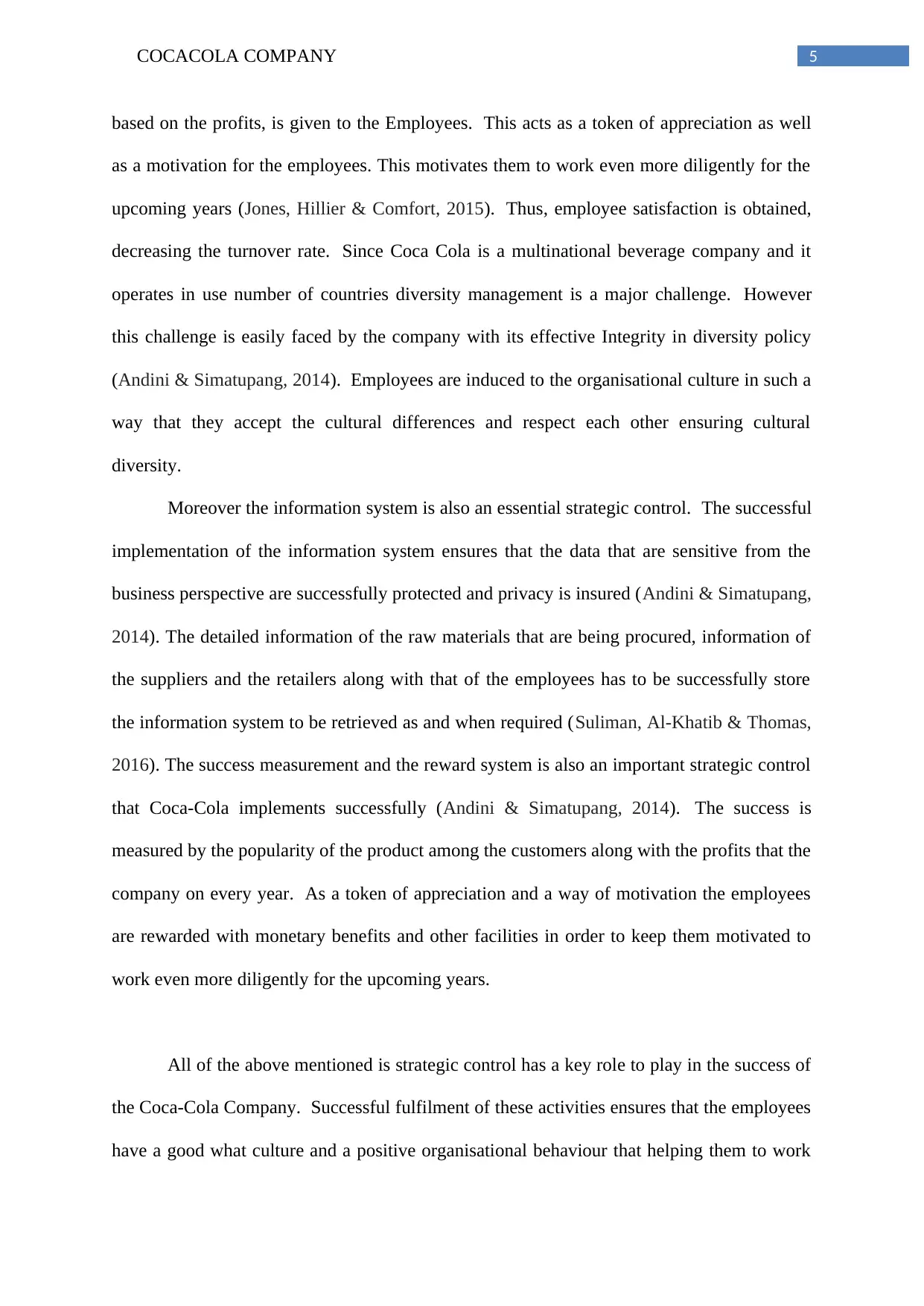
5COCACOLA COMPANY
based on the profits, is given to the Employees. This acts as a token of appreciation as well
as a motivation for the employees. This motivates them to work even more diligently for the
upcoming years (Jones, Hillier & Comfort, 2015). Thus, employee satisfaction is obtained,
decreasing the turnover rate. Since Coca Cola is a multinational beverage company and it
operates in use number of countries diversity management is a major challenge. However
this challenge is easily faced by the company with its effective Integrity in diversity policy
(Andini & Simatupang, 2014). Employees are induced to the organisational culture in such a
way that they accept the cultural differences and respect each other ensuring cultural
diversity.
Moreover the information system is also an essential strategic control. The successful
implementation of the information system ensures that the data that are sensitive from the
business perspective are successfully protected and privacy is insured (Andini & Simatupang,
2014). The detailed information of the raw materials that are being procured, information of
the suppliers and the retailers along with that of the employees has to be successfully store
the information system to be retrieved as and when required (Suliman, Al-Khatib & Thomas,
2016). The success measurement and the reward system is also an important strategic control
that Coca-Cola implements successfully (Andini & Simatupang, 2014). The success is
measured by the popularity of the product among the customers along with the profits that the
company on every year. As a token of appreciation and a way of motivation the employees
are rewarded with monetary benefits and other facilities in order to keep them motivated to
work even more diligently for the upcoming years.
All of the above mentioned is strategic control has a key role to play in the success of
the Coca-Cola Company. Successful fulfilment of these activities ensures that the employees
have a good what culture and a positive organisational behaviour that helping them to work
based on the profits, is given to the Employees. This acts as a token of appreciation as well
as a motivation for the employees. This motivates them to work even more diligently for the
upcoming years (Jones, Hillier & Comfort, 2015). Thus, employee satisfaction is obtained,
decreasing the turnover rate. Since Coca Cola is a multinational beverage company and it
operates in use number of countries diversity management is a major challenge. However
this challenge is easily faced by the company with its effective Integrity in diversity policy
(Andini & Simatupang, 2014). Employees are induced to the organisational culture in such a
way that they accept the cultural differences and respect each other ensuring cultural
diversity.
Moreover the information system is also an essential strategic control. The successful
implementation of the information system ensures that the data that are sensitive from the
business perspective are successfully protected and privacy is insured (Andini & Simatupang,
2014). The detailed information of the raw materials that are being procured, information of
the suppliers and the retailers along with that of the employees has to be successfully store
the information system to be retrieved as and when required (Suliman, Al-Khatib & Thomas,
2016). The success measurement and the reward system is also an important strategic control
that Coca-Cola implements successfully (Andini & Simatupang, 2014). The success is
measured by the popularity of the product among the customers along with the profits that the
company on every year. As a token of appreciation and a way of motivation the employees
are rewarded with monetary benefits and other facilities in order to keep them motivated to
work even more diligently for the upcoming years.
All of the above mentioned is strategic control has a key role to play in the success of
the Coca-Cola Company. Successful fulfilment of these activities ensures that the employees
have a good what culture and a positive organisational behaviour that helping them to work
⊘ This is a preview!⊘
Do you want full access?
Subscribe today to unlock all pages.

Trusted by 1+ million students worldwide
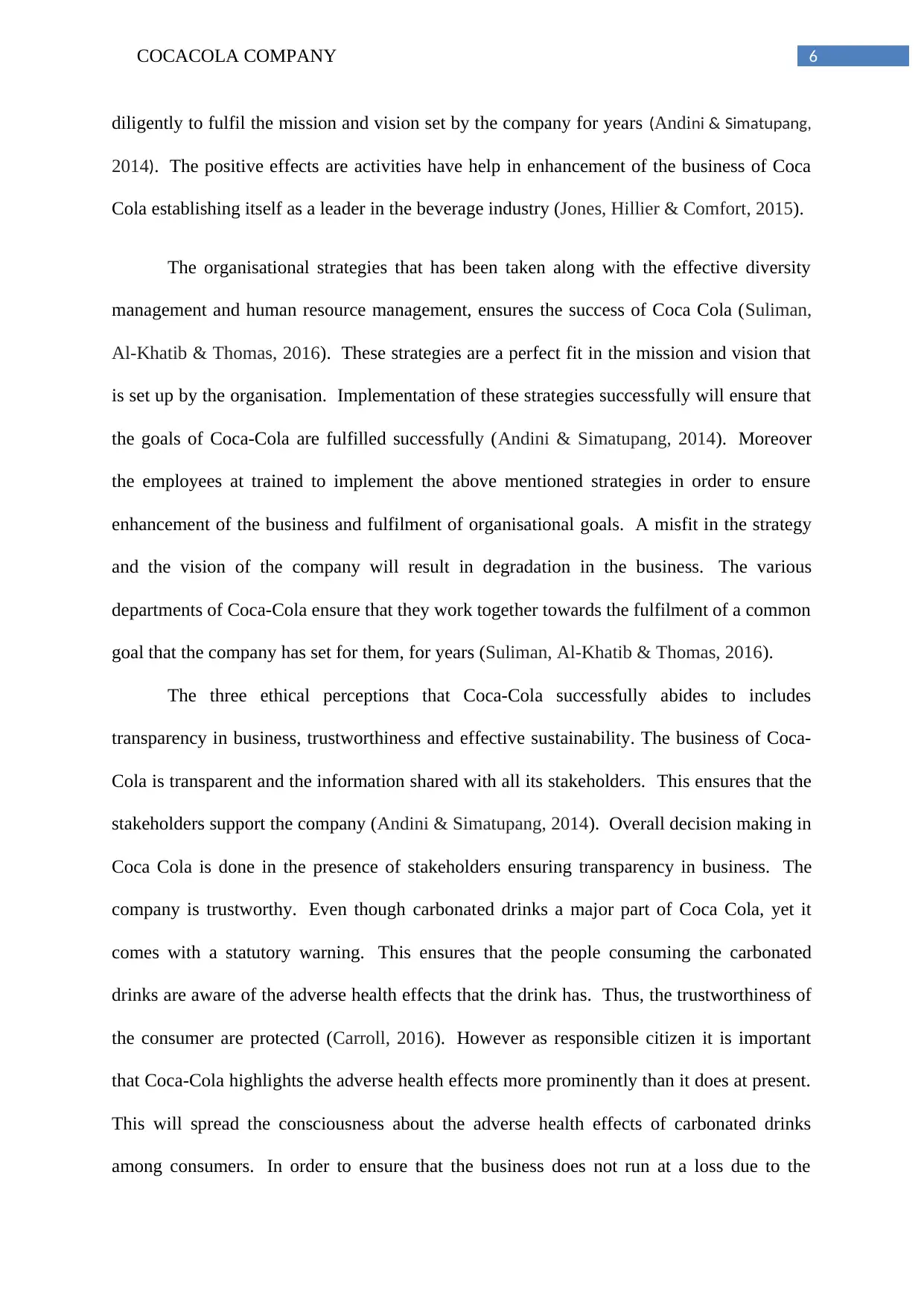
6COCACOLA COMPANY
diligently to fulfil the mission and vision set by the company for years (Andini & Simatupang,
2014). The positive effects are activities have help in enhancement of the business of Coca
Cola establishing itself as a leader in the beverage industry (Jones, Hillier & Comfort, 2015).
The organisational strategies that has been taken along with the effective diversity
management and human resource management, ensures the success of Coca Cola (Suliman,
Al-Khatib & Thomas, 2016). These strategies are a perfect fit in the mission and vision that
is set up by the organisation. Implementation of these strategies successfully will ensure that
the goals of Coca-Cola are fulfilled successfully (Andini & Simatupang, 2014). Moreover
the employees at trained to implement the above mentioned strategies in order to ensure
enhancement of the business and fulfilment of organisational goals. A misfit in the strategy
and the vision of the company will result in degradation in the business. The various
departments of Coca-Cola ensure that they work together towards the fulfilment of a common
goal that the company has set for them, for years (Suliman, Al-Khatib & Thomas, 2016).
The three ethical perceptions that Coca-Cola successfully abides to includes
transparency in business, trustworthiness and effective sustainability. The business of Coca-
Cola is transparent and the information shared with all its stakeholders. This ensures that the
stakeholders support the company (Andini & Simatupang, 2014). Overall decision making in
Coca Cola is done in the presence of stakeholders ensuring transparency in business. The
company is trustworthy. Even though carbonated drinks a major part of Coca Cola, yet it
comes with a statutory warning. This ensures that the people consuming the carbonated
drinks are aware of the adverse health effects that the drink has. Thus, the trustworthiness of
the consumer are protected (Carroll, 2016). However as responsible citizen it is important
that Coca-Cola highlights the adverse health effects more prominently than it does at present.
This will spread the consciousness about the adverse health effects of carbonated drinks
among consumers. In order to ensure that the business does not run at a loss due to the
diligently to fulfil the mission and vision set by the company for years (Andini & Simatupang,
2014). The positive effects are activities have help in enhancement of the business of Coca
Cola establishing itself as a leader in the beverage industry (Jones, Hillier & Comfort, 2015).
The organisational strategies that has been taken along with the effective diversity
management and human resource management, ensures the success of Coca Cola (Suliman,
Al-Khatib & Thomas, 2016). These strategies are a perfect fit in the mission and vision that
is set up by the organisation. Implementation of these strategies successfully will ensure that
the goals of Coca-Cola are fulfilled successfully (Andini & Simatupang, 2014). Moreover
the employees at trained to implement the above mentioned strategies in order to ensure
enhancement of the business and fulfilment of organisational goals. A misfit in the strategy
and the vision of the company will result in degradation in the business. The various
departments of Coca-Cola ensure that they work together towards the fulfilment of a common
goal that the company has set for them, for years (Suliman, Al-Khatib & Thomas, 2016).
The three ethical perceptions that Coca-Cola successfully abides to includes
transparency in business, trustworthiness and effective sustainability. The business of Coca-
Cola is transparent and the information shared with all its stakeholders. This ensures that the
stakeholders support the company (Andini & Simatupang, 2014). Overall decision making in
Coca Cola is done in the presence of stakeholders ensuring transparency in business. The
company is trustworthy. Even though carbonated drinks a major part of Coca Cola, yet it
comes with a statutory warning. This ensures that the people consuming the carbonated
drinks are aware of the adverse health effects that the drink has. Thus, the trustworthiness of
the consumer are protected (Carroll, 2016). However as responsible citizen it is important
that Coca-Cola highlights the adverse health effects more prominently than it does at present.
This will spread the consciousness about the adverse health effects of carbonated drinks
among consumers. In order to ensure that the business does not run at a loss due to the
Paraphrase This Document
Need a fresh take? Get an instant paraphrase of this document with our AI Paraphraser
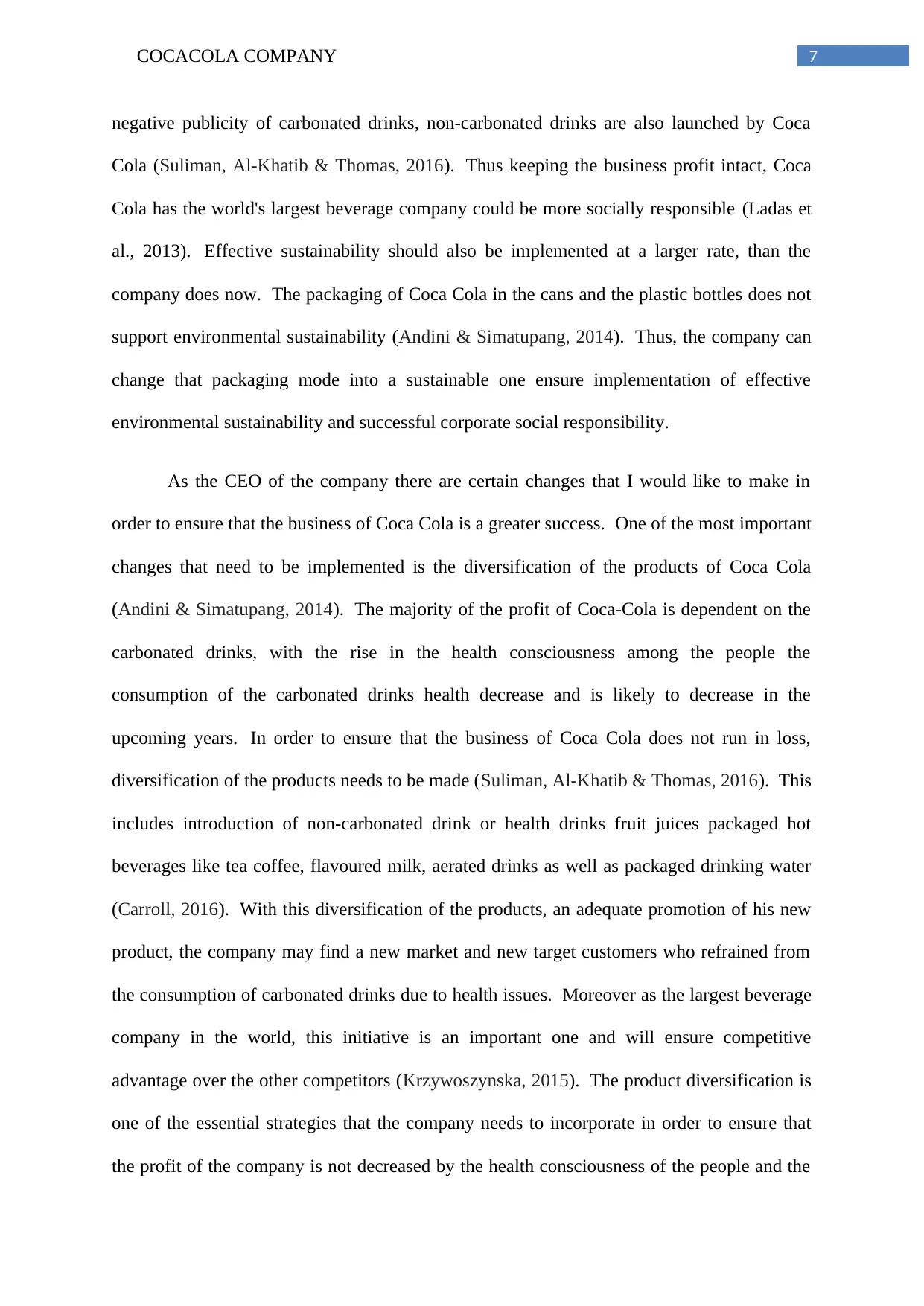
7COCACOLA COMPANY
negative publicity of carbonated drinks, non-carbonated drinks are also launched by Coca
Cola (Suliman, Al-Khatib & Thomas, 2016). Thus keeping the business profit intact, Coca
Cola has the world's largest beverage company could be more socially responsible (Ladas et
al., 2013). Effective sustainability should also be implemented at a larger rate, than the
company does now. The packaging of Coca Cola in the cans and the plastic bottles does not
support environmental sustainability (Andini & Simatupang, 2014). Thus, the company can
change that packaging mode into a sustainable one ensure implementation of effective
environmental sustainability and successful corporate social responsibility.
As the CEO of the company there are certain changes that I would like to make in
order to ensure that the business of Coca Cola is a greater success. One of the most important
changes that need to be implemented is the diversification of the products of Coca Cola
(Andini & Simatupang, 2014). The majority of the profit of Coca-Cola is dependent on the
carbonated drinks, with the rise in the health consciousness among the people the
consumption of the carbonated drinks health decrease and is likely to decrease in the
upcoming years. In order to ensure that the business of Coca Cola does not run in loss,
diversification of the products needs to be made (Suliman, Al-Khatib & Thomas, 2016). This
includes introduction of non-carbonated drink or health drinks fruit juices packaged hot
beverages like tea coffee, flavoured milk, aerated drinks as well as packaged drinking water
(Carroll, 2016). With this diversification of the products, an adequate promotion of his new
product, the company may find a new market and new target customers who refrained from
the consumption of carbonated drinks due to health issues. Moreover as the largest beverage
company in the world, this initiative is an important one and will ensure competitive
advantage over the other competitors (Krzywoszynska, 2015). The product diversification is
one of the essential strategies that the company needs to incorporate in order to ensure that
the profit of the company is not decreased by the health consciousness of the people and the
negative publicity of carbonated drinks, non-carbonated drinks are also launched by Coca
Cola (Suliman, Al-Khatib & Thomas, 2016). Thus keeping the business profit intact, Coca
Cola has the world's largest beverage company could be more socially responsible (Ladas et
al., 2013). Effective sustainability should also be implemented at a larger rate, than the
company does now. The packaging of Coca Cola in the cans and the plastic bottles does not
support environmental sustainability (Andini & Simatupang, 2014). Thus, the company can
change that packaging mode into a sustainable one ensure implementation of effective
environmental sustainability and successful corporate social responsibility.
As the CEO of the company there are certain changes that I would like to make in
order to ensure that the business of Coca Cola is a greater success. One of the most important
changes that need to be implemented is the diversification of the products of Coca Cola
(Andini & Simatupang, 2014). The majority of the profit of Coca-Cola is dependent on the
carbonated drinks, with the rise in the health consciousness among the people the
consumption of the carbonated drinks health decrease and is likely to decrease in the
upcoming years. In order to ensure that the business of Coca Cola does not run in loss,
diversification of the products needs to be made (Suliman, Al-Khatib & Thomas, 2016). This
includes introduction of non-carbonated drink or health drinks fruit juices packaged hot
beverages like tea coffee, flavoured milk, aerated drinks as well as packaged drinking water
(Carroll, 2016). With this diversification of the products, an adequate promotion of his new
product, the company may find a new market and new target customers who refrained from
the consumption of carbonated drinks due to health issues. Moreover as the largest beverage
company in the world, this initiative is an important one and will ensure competitive
advantage over the other competitors (Krzywoszynska, 2015). The product diversification is
one of the essential strategies that the company needs to incorporate in order to ensure that
the profit of the company is not decreased by the health consciousness of the people and the
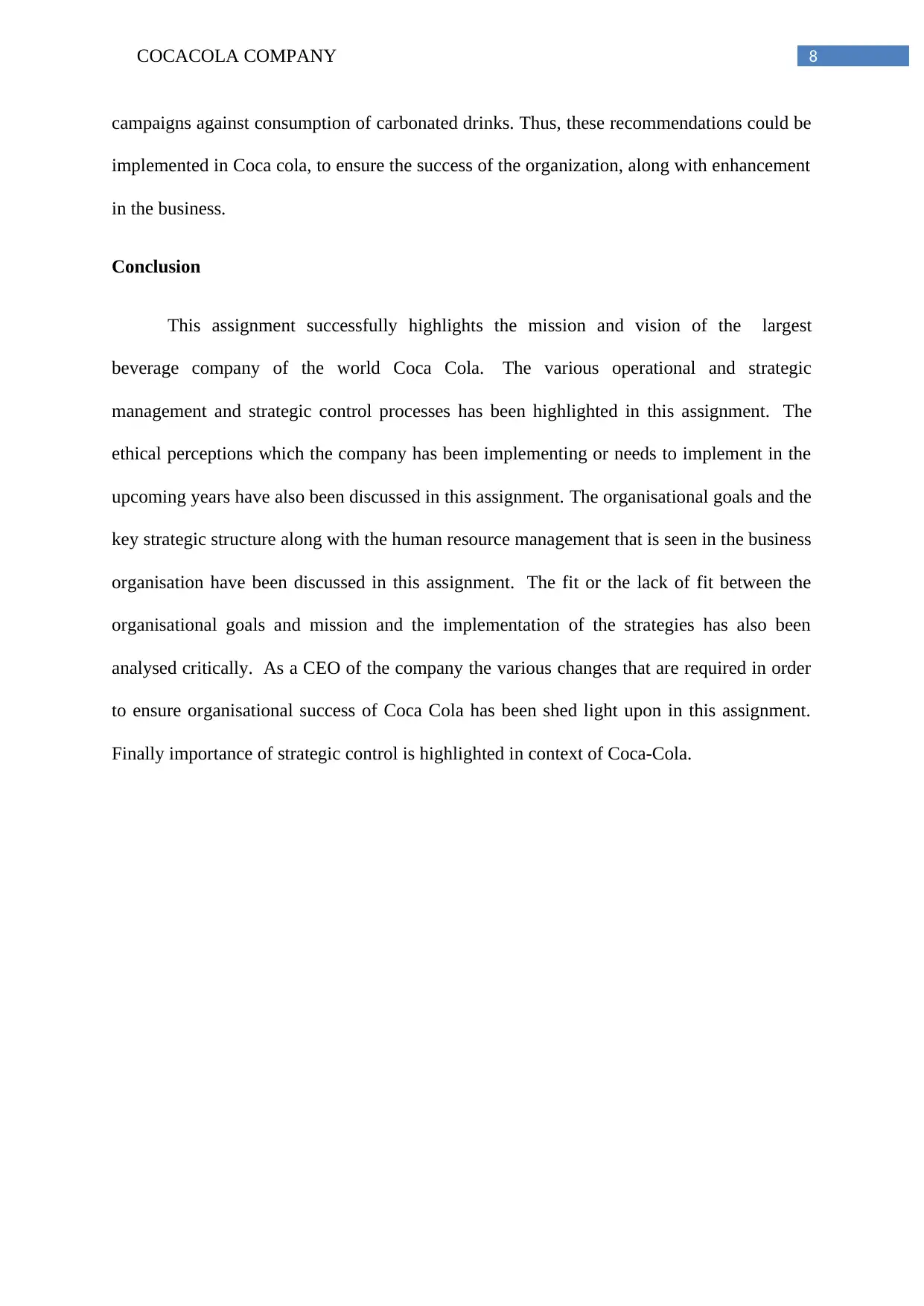
8COCACOLA COMPANY
campaigns against consumption of carbonated drinks. Thus, these recommendations could be
implemented in Coca cola, to ensure the success of the organization, along with enhancement
in the business.
Conclusion
This assignment successfully highlights the mission and vision of the largest
beverage company of the world Coca Cola. The various operational and strategic
management and strategic control processes has been highlighted in this assignment. The
ethical perceptions which the company has been implementing or needs to implement in the
upcoming years have also been discussed in this assignment. The organisational goals and the
key strategic structure along with the human resource management that is seen in the business
organisation have been discussed in this assignment. The fit or the lack of fit between the
organisational goals and mission and the implementation of the strategies has also been
analysed critically. As a CEO of the company the various changes that are required in order
to ensure organisational success of Coca Cola has been shed light upon in this assignment.
Finally importance of strategic control is highlighted in context of Coca-Cola.
campaigns against consumption of carbonated drinks. Thus, these recommendations could be
implemented in Coca cola, to ensure the success of the organization, along with enhancement
in the business.
Conclusion
This assignment successfully highlights the mission and vision of the largest
beverage company of the world Coca Cola. The various operational and strategic
management and strategic control processes has been highlighted in this assignment. The
ethical perceptions which the company has been implementing or needs to implement in the
upcoming years have also been discussed in this assignment. The organisational goals and the
key strategic structure along with the human resource management that is seen in the business
organisation have been discussed in this assignment. The fit or the lack of fit between the
organisational goals and mission and the implementation of the strategies has also been
analysed critically. As a CEO of the company the various changes that are required in order
to ensure organisational success of Coca Cola has been shed light upon in this assignment.
Finally importance of strategic control is highlighted in context of Coca-Cola.
⊘ This is a preview!⊘
Do you want full access?
Subscribe today to unlock all pages.

Trusted by 1+ million students worldwide
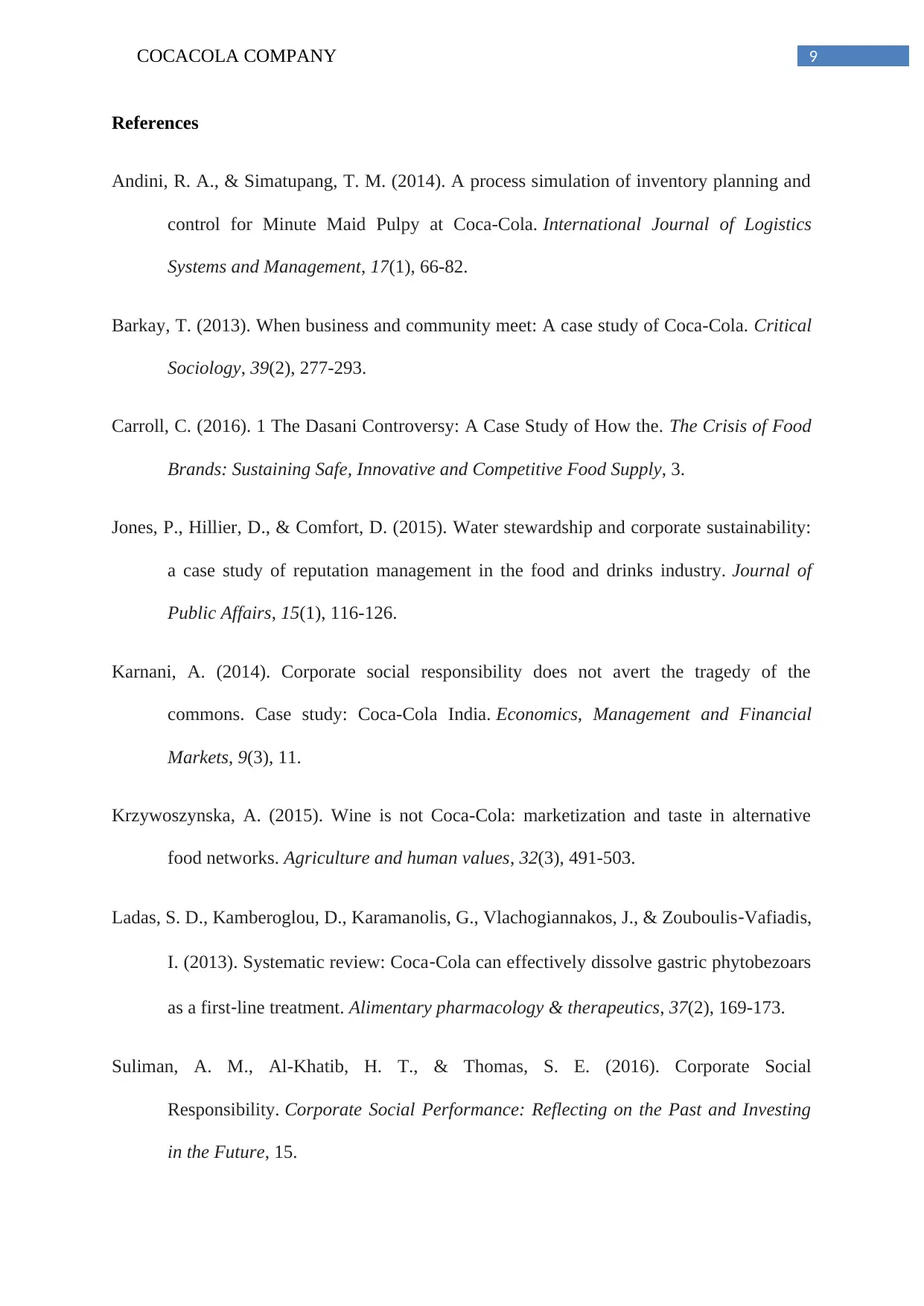
9COCACOLA COMPANY
References
Andini, R. A., & Simatupang, T. M. (2014). A process simulation of inventory planning and
control for Minute Maid Pulpy at Coca-Cola. International Journal of Logistics
Systems and Management, 17(1), 66-82.
Barkay, T. (2013). When business and community meet: A case study of Coca-Cola. Critical
Sociology, 39(2), 277-293.
Carroll, C. (2016). 1 The Dasani Controversy: A Case Study of How the. The Crisis of Food
Brands: Sustaining Safe, Innovative and Competitive Food Supply, 3.
Jones, P., Hillier, D., & Comfort, D. (2015). Water stewardship and corporate sustainability:
a case study of reputation management in the food and drinks industry. Journal of
Public Affairs, 15(1), 116-126.
Karnani, A. (2014). Corporate social responsibility does not avert the tragedy of the
commons. Case study: Coca-Cola India. Economics, Management and Financial
Markets, 9(3), 11.
Krzywoszynska, A. (2015). Wine is not Coca-Cola: marketization and taste in alternative
food networks. Agriculture and human values, 32(3), 491-503.
Ladas, S. D., Kamberoglou, D., Karamanolis, G., Vlachogiannakos, J., & Zouboulis‐Vafiadis,
I. (2013). Systematic review: Coca‐Cola can effectively dissolve gastric phytobezoars
as a first‐line treatment. Alimentary pharmacology & therapeutics, 37(2), 169-173.
Suliman, A. M., Al-Khatib, H. T., & Thomas, S. E. (2016). Corporate Social
Responsibility. Corporate Social Performance: Reflecting on the Past and Investing
in the Future, 15.
References
Andini, R. A., & Simatupang, T. M. (2014). A process simulation of inventory planning and
control for Minute Maid Pulpy at Coca-Cola. International Journal of Logistics
Systems and Management, 17(1), 66-82.
Barkay, T. (2013). When business and community meet: A case study of Coca-Cola. Critical
Sociology, 39(2), 277-293.
Carroll, C. (2016). 1 The Dasani Controversy: A Case Study of How the. The Crisis of Food
Brands: Sustaining Safe, Innovative and Competitive Food Supply, 3.
Jones, P., Hillier, D., & Comfort, D. (2015). Water stewardship and corporate sustainability:
a case study of reputation management in the food and drinks industry. Journal of
Public Affairs, 15(1), 116-126.
Karnani, A. (2014). Corporate social responsibility does not avert the tragedy of the
commons. Case study: Coca-Cola India. Economics, Management and Financial
Markets, 9(3), 11.
Krzywoszynska, A. (2015). Wine is not Coca-Cola: marketization and taste in alternative
food networks. Agriculture and human values, 32(3), 491-503.
Ladas, S. D., Kamberoglou, D., Karamanolis, G., Vlachogiannakos, J., & Zouboulis‐Vafiadis,
I. (2013). Systematic review: Coca‐Cola can effectively dissolve gastric phytobezoars
as a first‐line treatment. Alimentary pharmacology & therapeutics, 37(2), 169-173.
Suliman, A. M., Al-Khatib, H. T., & Thomas, S. E. (2016). Corporate Social
Responsibility. Corporate Social Performance: Reflecting on the Past and Investing
in the Future, 15.
Paraphrase This Document
Need a fresh take? Get an instant paraphrase of this document with our AI Paraphraser
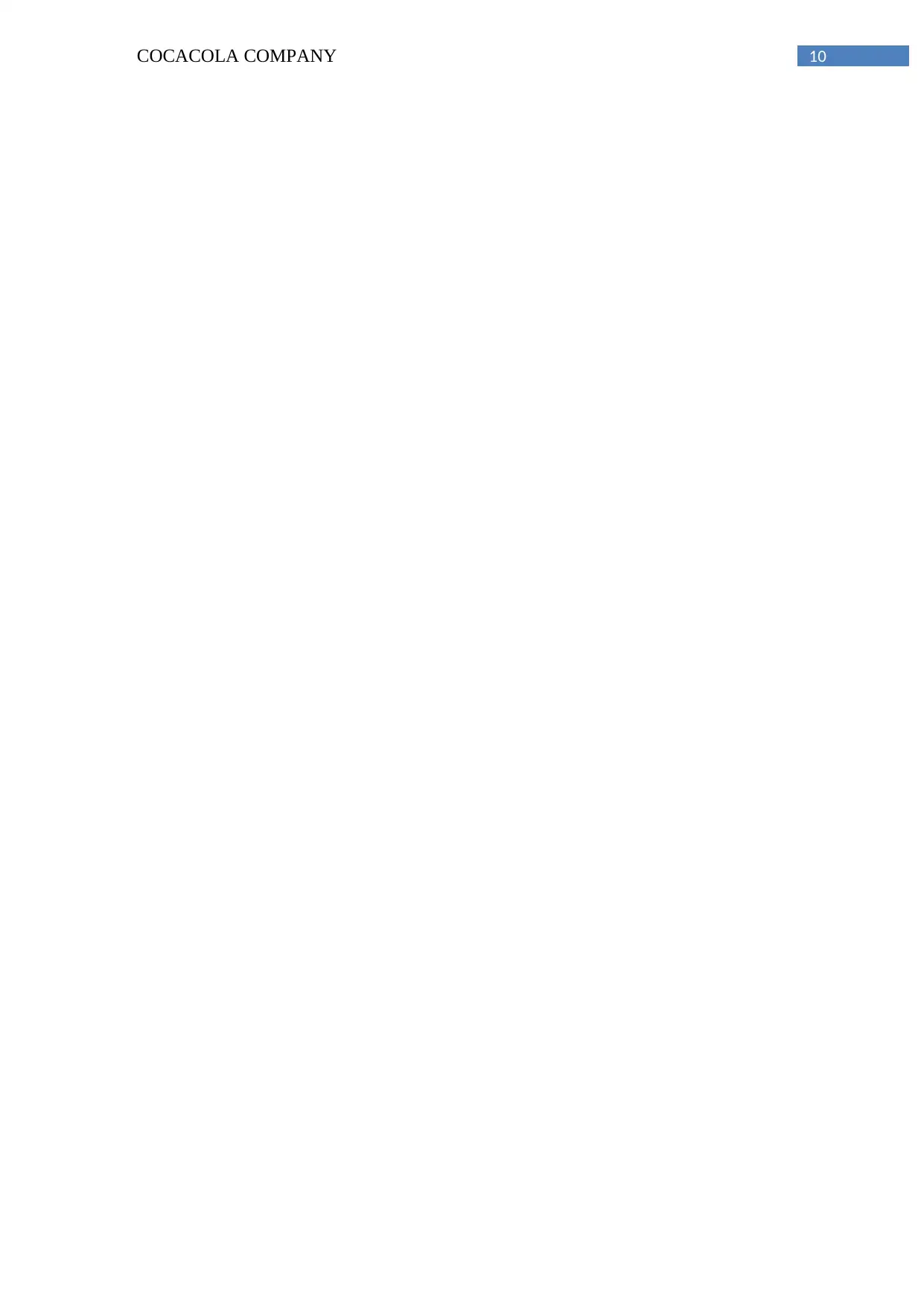
10COCACOLA COMPANY
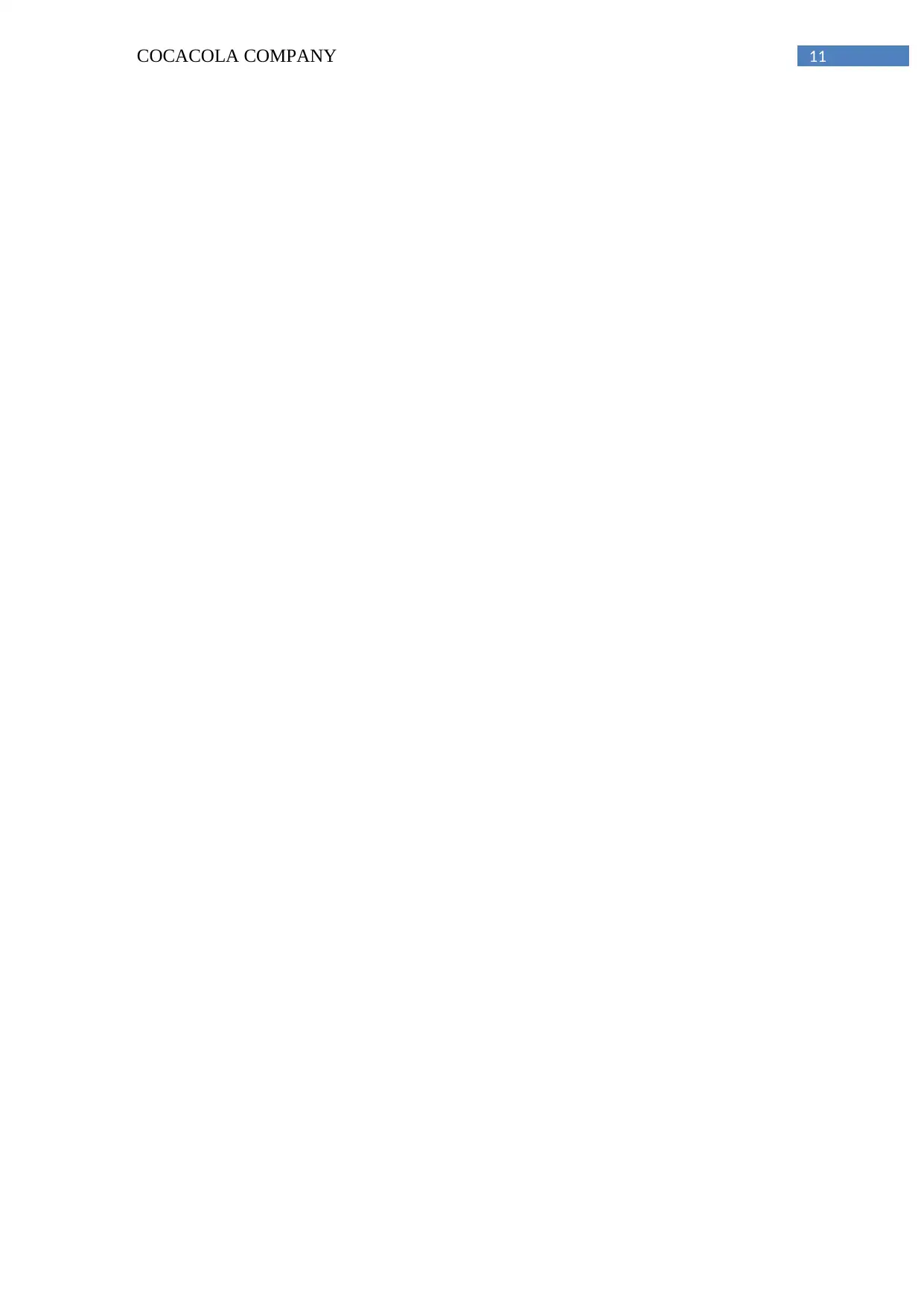
11COCACOLA COMPANY
⊘ This is a preview!⊘
Do you want full access?
Subscribe today to unlock all pages.

Trusted by 1+ million students worldwide
1 out of 12
Related Documents
Your All-in-One AI-Powered Toolkit for Academic Success.
+13062052269
info@desklib.com
Available 24*7 on WhatsApp / Email
![[object Object]](/_next/static/media/star-bottom.7253800d.svg)
Unlock your academic potential
Copyright © 2020–2025 A2Z Services. All Rights Reserved. Developed and managed by ZUCOL.





